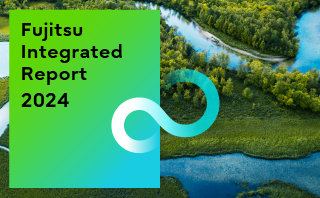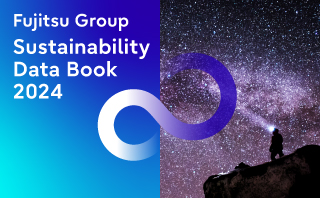-
Sustainability at Fujitsu Group
- Sustainability Management in the Fujitsu Group
- GRB(Global Responsible Business)Goals and Achievments for FY2022
- GRB(Global Responsible Business)Goals for FY2025
- Fujitsu's accessibility
- Stakeholder Engagement
- United Nations Global Compact
- SDG-related Activities in Fujitsu
- External Recognition and Awards
-
Global Responsible Business
- Environment
-
- Environmental Management
- The Fujitsu Group Environmental Vision on Climate Change
- Living in Harmony with Nature (Conservation of Biodiversity)
- Environmental Action Plan
- Environmental Data
- Environmental Communication
- Environmental Social Activities
- Disposal and Recycling of ICT products
- Environmental Considerations in ICT Products
- Governance
-
Data and Documents
- Fujitsu Group Sustainability Data Book 2024
- Social, Governance and Environmental data
- Independent Assurance Report

- GRI Standards / United Nations Global Compact (UNGC) principles Comparison Table
- SASB Standards Comparison Table
- Sustainability Information Disclosure Framework
- Link to regions responsible business reports
- Contact
- Sitemap
Fujitsu Group Environmental Action Plan (Stage X)
The Global Risks Report 2021 (*1) ranks as major risks, by likelihood of occurrence and by impact, climate-related matters including climate change, resource circulation and biodiversity loss. Regarding climate change, the IPCC’s special report Global Warming of 1.5°C (*2) recommends a more rapid transition to a decarbonized society. The global initiative Science Based Targets set a goal for reductions in greenhouse gas (GHG) emissions to limit global warming to 1.5°C and called on companies to set their own ambitious targets.
In terms of resource circulation, the issue of waste plastics is a global concern and the use of plastics is being questioned in Japan and elsewhere. As for biodiversity, when considering a post-2020 biodiversity target, we are discussing ways of reducing negative impacts on biodiversity throughout our supply chain.
Given this background, the Fujitsu Group has specified targets that address the three global societal challenges of climate change, resource circulation and living in harmony with nature (conservation of biodiversity). As we undertake workstyle reforms and restructure our business operations, we will focus on these targets over the two-year period from FY 2021 to FY 2022 by working to minimize negative environmental impacts in the supply chain.
- (*1)An annual report issued by the World Economic Forum that lists, by likelihood and by impact, the major risks facing the world.
- (*2)A special report issued by the Intergovernmental Panel on Climate Change (IPCC). This report was submitted to the 48th Session of the IPCC in October 2018.
Climate Change
| Targets (to be achieved by FY2022) | FY2022 results |
|---|---|
| 1. Reduce greenhouse gas (GHG) emissions from business sites each year by 4.2% or more, compared with the base year of FY2013 | 10.5% reduction (47.5% reduction compared to baseline year) (*3) |
| 2.Improve PUE (*4) (Power Usage Effectiveness) of our data centers by 3%, compared with FY2017 | PUE 1.57 - Improvement of 1.2% |
| 3. Increase renewable energy usage to 16% of total electricity | 30.0% |
| 4. Reduce CO2 emissions due to power consumption during product usage by 17% or more, compared with FY2013 | Reduced by 25% |
| 5. Drive activities to reduce CO2 emissions in the upstream supply chain. | Requested that secondary suppliers (over 61,000 companies) engaged in activities to reduce emissions through primary suppliers of the Fujitsu Group (676 companies) |
Resource Circulation
| Targets (to be achieved by FY2022) | FY2022 results |
|---|---|
| 6. Promote eco design for resource saving and circulation and increase resource efficiency of newly developed products by 10% or more, compared with FY2019 | Improved by 11.2% |
| 7. Reduce water usage by 30,000 m3 or more by implementing water resource conservation measures | Water consumption was reduced 31,000 m3 (target for FY 2022: 19,000 m3) |
| 8. Reinforce awareness of the need to conserve water resources in the upstream supply chain | Requested that 676 of the Fujitsu Group's primary suppliers engage in activities to conserve water |
Living in Harmony with Nature (Conservation of Biodiversity)
| Targets (to be achieved by FY2022) | FY2022 results |
|---|---|
| 9. Visualize and reduce the impact of corporate activities on ecosystems and on biodiversity | Establishment of a calculation method that uses Ecological Footprint (EF) as the indicator for visualizing the impact of corporate activities on biodiversity |
- (*3)Reduction rate based on market standards
- (*4)PUE (Power Usage Effectiveness): An indicator of the efficiency of electric power usage by the data center. This value is calculated by dividing the data center's total electric power consumption by the electric power consumption of servers and other ICT devices. The closer the value is to 1.0, the higher is the efficiency.
RELATED LINKS
- Fujitsu Group Environmental Action Plan (Stage IX)
https://www.fujitsu.com/global/about/environment/approach/plan/stage9/ - Fujitsu Group Environmental Action Plan (Stage VIII)
https://www.fujitsu.com/global/about/environment/approach/plan/stage8/ - Fujitsu Group Environmental Action Plan (Stage VII)
https://www.fujitsu.com/global/about/environment/approach/plan/stage7/ - Fujitsu Group Environmental Protection Program (Stage VI)
https://www.fujitsu.com/global/about/environment/approach/plan/stage6/ - Fujitsu Group Environmental Protection Program (Stage V)
https://www.fujitsu.com/global/about/environment/approach/plan/stage5/ - Fujitsu Group Environmental Protection Program (Stage IV)
https://www.fujitsu.com/global/about/environment/approach/plan/stage4/ - Fujitsu Group Environmental Protection Program (Stage III)
https://www.fujitsu.com/global/about/environment/approach/plan/stage3/


